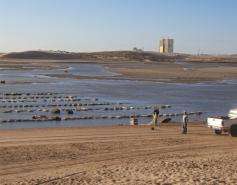Team identifies water vulnerability in border region

The Arizona-Sonora region has been called the front line of ongoing climate change, with global climate models projecting severe precipitation decreases and temperature increases coupled with vulnerability from urbanization, industrialization and agricultural intensification.
A team of bilingual and binational researchers from the University of Arizona and the Colegio de Sonora in Hermosillo, Sonora, Mexico has issued a casebook that depicts the water vulnerability and potential adaptation to climate change throughout the Arizona-Sonora region.
For the last three years, the research team has worked closely with water managers, disaster relief planners and other decision-makers in Arizona and Sonora to study the vulnerability of the region's water resources to climate variability and change. It also assessed the capacity that governments, private enterprises and individuals might have to better prepare for, or adapt to, such changes.
The researchers were supported by a grant from the National Oceanic and Atmospheric Administration, known as NOAA, and produced detailed case studies of the water-climate vulnerability and adaptation situation for four communities: Tucson, Ariz.; the twinned border cities of Nogales, Ariz., and Nogales, Sonora; Hermosillo, Sonora.; and Puerto Peñasco, Sonora.
The region has been called the front line of ongoing climate change, with global climate models for the region projecting severe precipitation decreases and temperature increases coupled with vulnerability from urbanization, industrialization and agricultural intensification.
Specifically, researchers found increased vulnerability of urban water users to climatic changes because of factors such as aging or inadequate water-delivery infrastructure, over-allocation of water resources within the region and the location of poor neighborhoods in flood-prone areas or other areas at risk. Adding to vulnerability issues, agriculture was noted as consuming approximately 70-80 percent of available water in the Arizona-Sonora region.
"The region is coping with water vulnerability in similar but also different ways," said research leader Margaret Wilder, associate professor at the Center for Latin American Studies and School of Geography and Development, with an appointment in the Udall Center for Studies in Public Policy.
She cited Arizona's experience in the Central Arizona Water Project and the Sonoran development of an aqueduct system to redirect water for farming into cities as projects wherein experience could be shared.
Wilder said, "The study has accomplished focusing research on the Arizona-Sonora region. By working collaboratively with researchers in Mexico and with various researchers in global climate change at the UA, the study has given us the opportunity to learn from one another in our approaches to the management of water resources and has resulted in putting border climate change on the radar."
The researchers define vulnerability as negative impacts from climate stressors or shocks, while adaptive capacity refers to the ability or inability of individuals and social groups to respond, cope, recover or adapt to any external stress placed on their livelihoods and well-being.
For each of the communities, the researchers determined the vulnerability of the water sector to climate changes, the capacity to plan and respond to these vulnerabilities relative to future water needs, and the ability of water managers and preparedness planners to use climate science and information for improved long-range decision-making and adaptation.
The researchers conclude each case study by discussing the overall implications for water resources planning and policymaking in the respective community.
Next for the team is a series of stakeholder workshops that will be held to indentify indicators of adaptive capacity and to address innovations in meeting the climate information needs of stakeholders with the climate change information being produced by the scientific community.
They are producing a quarterly binational climate summary in English and Spanish that provides timely and regionally focused climate information co-produced by policymakers and the scientific community.
Provided by University of Arizona
















